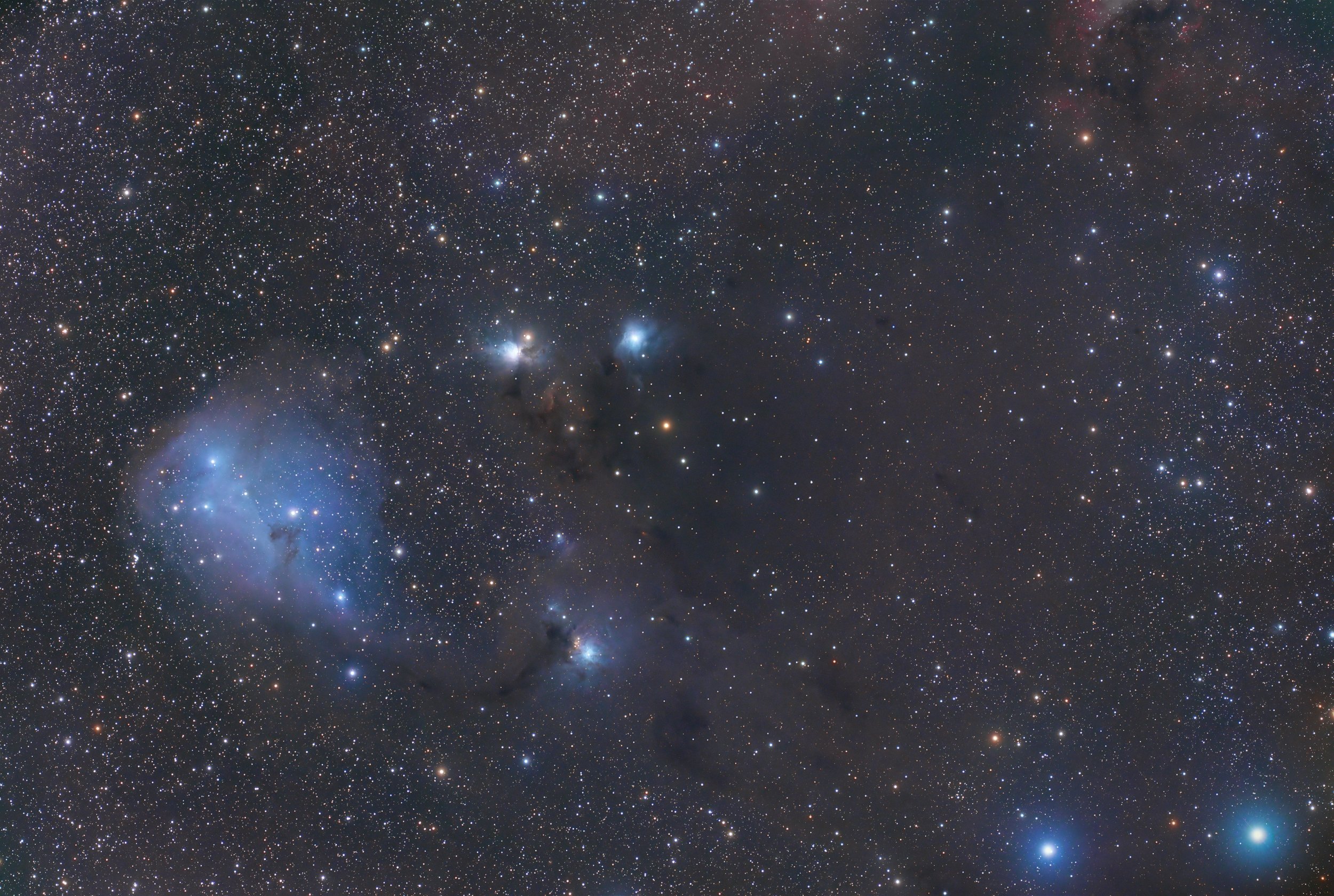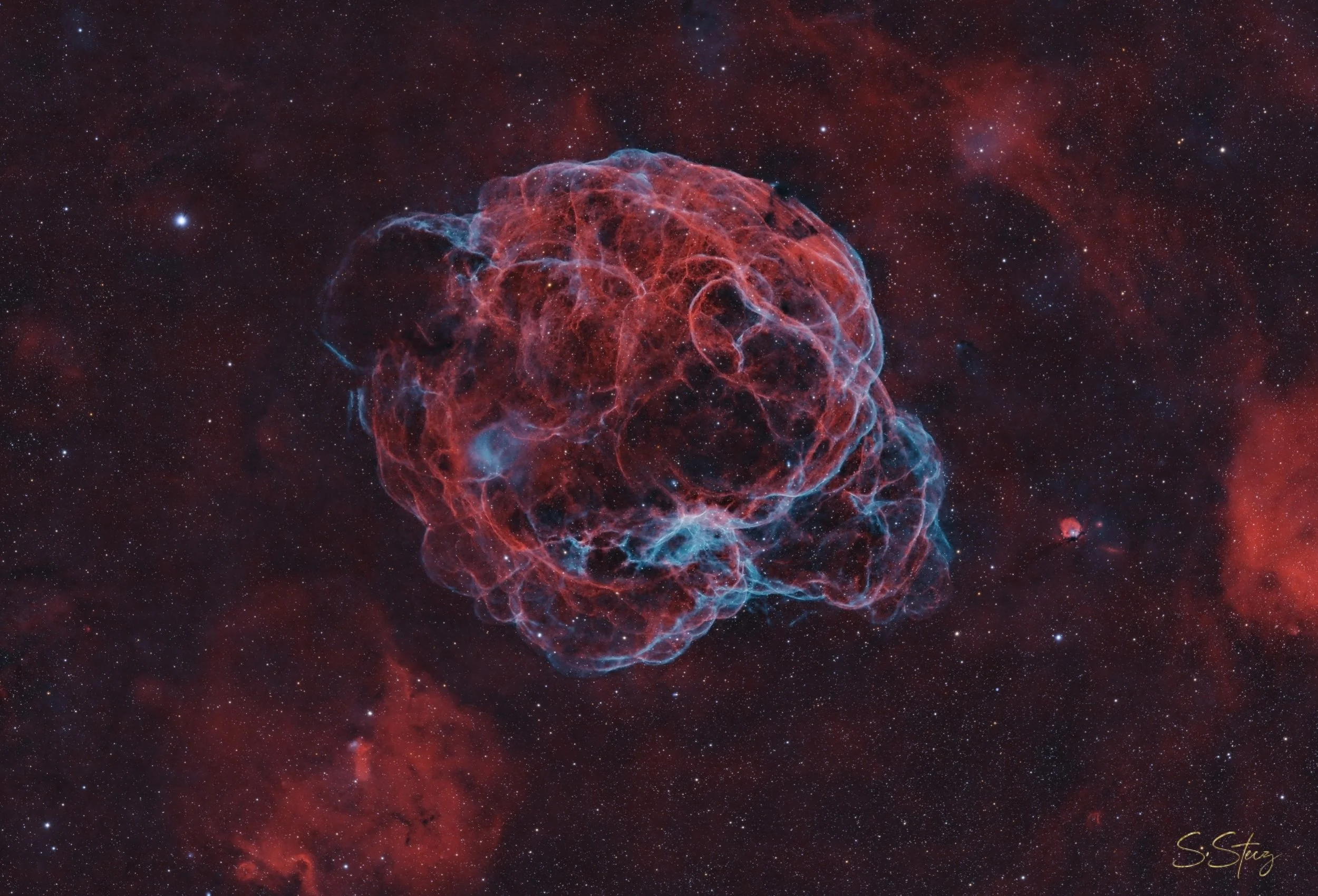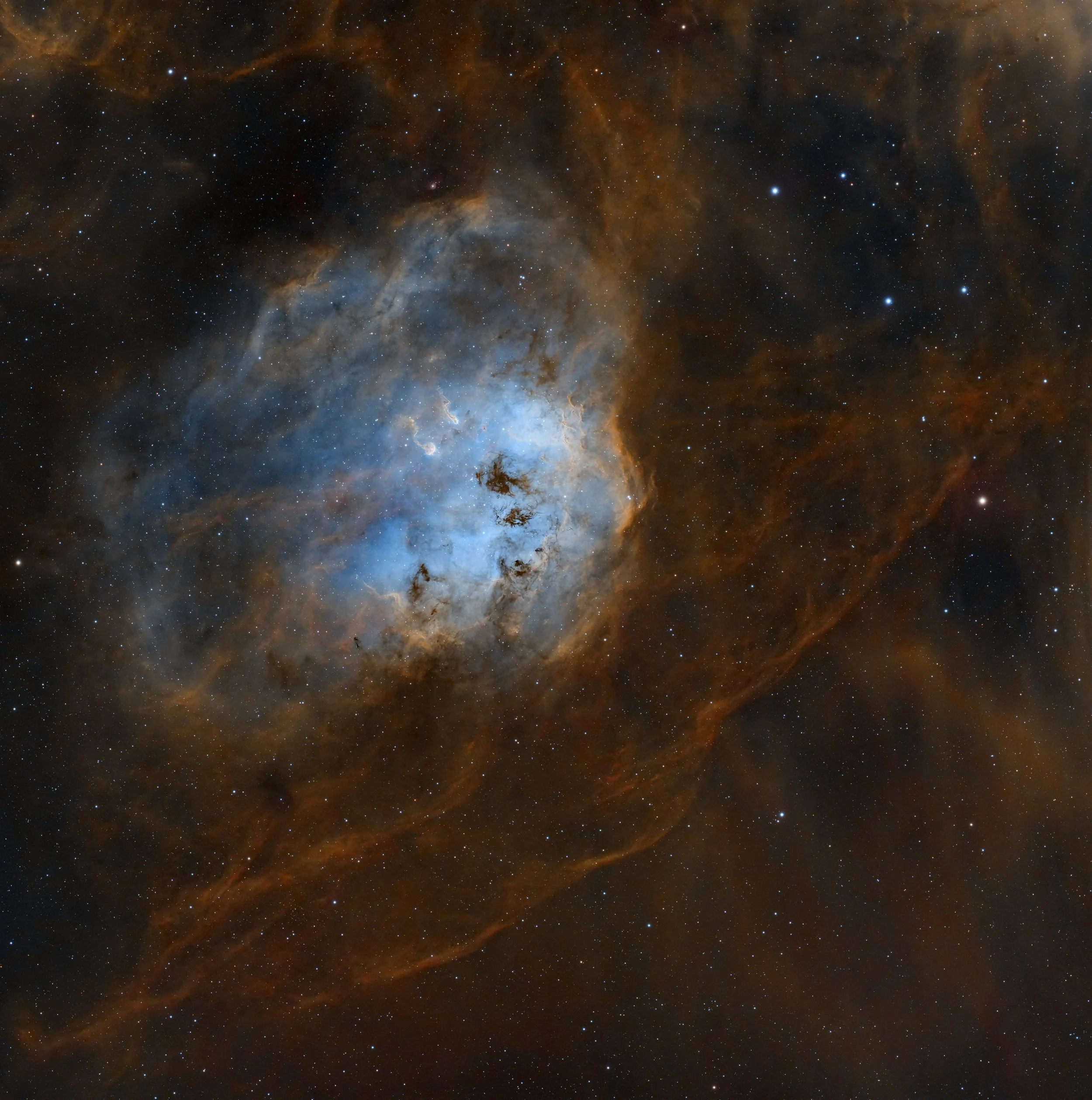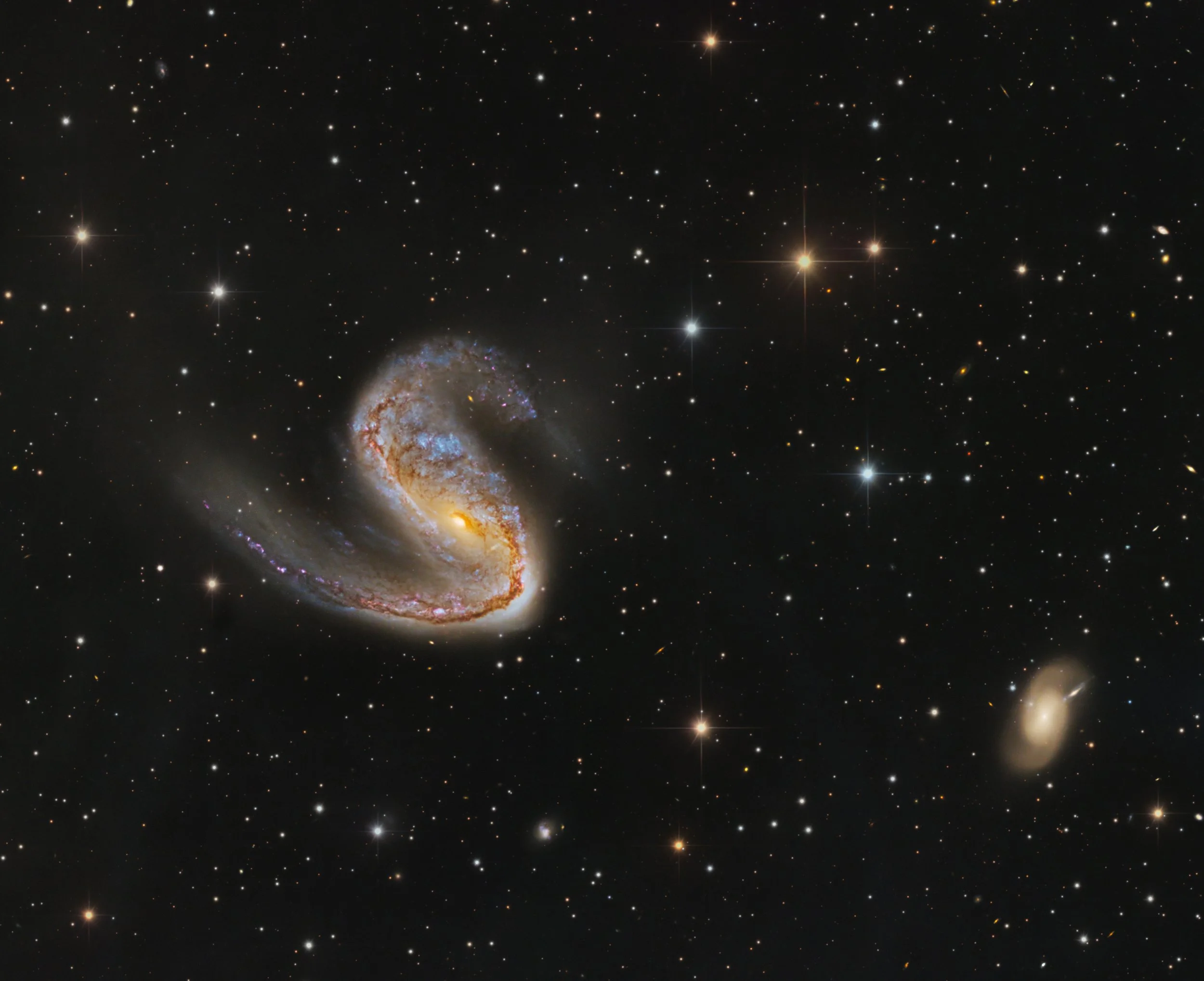
AAPOD2 Image Archives
Sh2-240 Spaghetti Nebula
A delicate tangle of filaments drifts through the void in this ethereal portrait of Sh2-240, more commonly known as the Spaghetti Nebula. This vast supernova remnant, spanning nearly 150 light-years across, is the ghostly aftermath of a massive star that exploded approximately 40,000 years ago. Situated on the border between the constellations Taurus and Auriga, this faint and expansive structure is one of the largest supernova remnants visible from Earth, though its tenuous tendrils of ionized gas make it a challenge to observe.
Captured in the HOO palette, this image isolates the nebula’s intricate web of filaments using hydrogen-alpha and oxygen-III emissions. The deep red hues trace the remnants of the progenitor star’s outer layers, while the soft cyan glows highlight the presence of oxygen-rich shock waves sweeping through interstellar space. These delicate strands, shaped by the expanding shock front, weave an intricate cosmic tapestry that is slowly dispersing into the surrounding medium.
Despite its ghostly appearance, Sh2-240 continues to shape its environment, compressing nearby gas clouds and potentially triggering the birth of new stars. As this ancient stellar remnant gradually fades into the depths of time, it serves as a reminder of the relentless cycle of stellar death and rebirth that sculpts the universe.
Regulus | Leo I
In this striking celestial portrait, the brilliant star Regulus, the heart of the constellation Leo, shines as a dazzling beacon against the cosmic backdrop. A massive blue-white main-sequence star, Regulus is one of the brightest stars in the night sky, spinning at an incredible speed—so fast that it takes on an oblate shape, stretched by its own rapid rotation.
Drifting near this stellar giant is Leo I, a faint but fascinating dwarf spheroidal galaxy. Situated about 820,000 light-years away, this satellite galaxy of the Milky Way is one of the most distant and elusive of the Local Group. Its diffuse structure is barely visible against the overwhelming glare of Regulus, making it a challenging target for observation. Despite its faintness, Leo I is an ancient relic of the early universe, home to predominantly older, metal-poor stars that formed billions of years ago.
This image, taken from Jalisco, México, masterfully balances the stark contrast between the intensely bright foreground star and the delicate, ghostly presence of Leo I. As light from these objects travels across vast cosmic distances, it offers a glimpse into both the brilliance of stellar evolution and the quiet persistence of galaxies bound to the Milky Way's gravitational influence.
The Bear's Paw
Nestled within the vast reaches of interstellar space, The Bear’s Paw—a striking deep-sky object—unveils its intricate structure through this detailed LRGB image. Captured under the skies of Modena, Italy, this celestial marvel showcases a dynamic interplay of gas, dust, and starlight, revealing the delicate tendrils and luminous knots that define its enigmatic form.
This deep-space structure is composed of dense molecular clouds and ionized gas, sculpted over millennia by the radiation and stellar winds of young, massive stars. The image’s luminance layer enhances the intricate filaments of the nebula, while the red, green, and blue channels bring forth the subtle hues of ionized hydrogen, oxygen, and sulfur. The delicate balance of light and shadow hints at ongoing star formation within the nebula’s depths, where gravitational forces are shaping the next generation of celestial bodies.
The surrounding cosmic environment is punctuated by a scattering of distant galaxies and foreground stars, offering a glimpse into the vastness of the universe beyond. As light from The Bear’s Paw traverses the cosmic expanse to reach our telescopes, it tells a silent but profound story of stellar birth, evolution, and the forces that govern our universe.
A Journey on Horseback: Barndar33 Horsehead Nebula
The Horsehead Nebula (Barnard 33), located in the Orion constellation approximately 1,500 light-years away, is a captivating dark nebula renowned for its distinct silhouette resembling a horse's head against the vibrant background of IC 434. This image was captured using the SHO (Sulfur-II, Hydrogen-alpha, Oxygen-III) narrowband palette, offering a unique perspective of this iconic region by mapping specific ionized gases to distinct colors.
The SHO technique highlights Sulfur-II emissions in red, Hydrogen-alpha in green, and Oxygen-III in blue, which provides insights beyond traditional broadband imaging. This method reveals lesser-known details, such as the intricate structures of ionization fronts and shock waves from nearby stellar winds. The blue hues in the image, corresponding to Oxygen-III, often trace the hotter, ionized regions around young, massive stars, while the reddish areas dominated by Sulfur-II can indicate regions of low-energy ionization, often associated with older stellar remnants or slower-moving ionized fronts. The green hydrogen-alpha emissions not only enhance the iconic glow of IC 434 but also bring out subtle textures in the surrounding molecular clouds, offering a deeper understanding of the chemical processes and star formation activities within this complex and beautiful region.
M44 – The Beehive Cluster
M44, also known as The Beehive Cluster or Praesepe, is an open star cluster located in the constellation Cancer, approximately 610 light-years away. This bright and densely packed cluster consists of several hundred stars, with many being solar-type and red dwarfs, making it one of the closest and most studied open clusters. Visible to the naked eye under dark skies, M44 has been known since antiquity and was cataloged by Ptolemy as a "nebulous mass" before telescopes resolved it into individual stars.
With an estimated age of 600–700 million years, the Beehive Cluster is of significant interest for studying stellar evolution. It shares similarities with the Hyades cluster in Taurus, suggesting a common origin. The cluster’s positioning within the ecliptic means it is frequently occulted by the Moon and occasionally by planets, offering excellent opportunities for observational studies.
Sh2-308 – The Dolphin Nebula
Sh2-308, also known as the Dolphin Nebula, is a large, faint emission nebula located in the constellation Canis Major, approximately 4,500 light-years away. This expansive bubble-shaped structure is formed by the strong stellar winds of the Wolf-Rayet star EZ Canis Majoris (EZ CMa), which is shedding its outer layers in the final stages of its evolution. The nebula's predominant oxygen emission gives it a characteristic bluish hue, contrasting against the surrounding interstellar medium.
Expanding at nearly 60 km/s, Sh2-308 spans over 60 light-years in diameter, making it one of the largest Wolf-Rayet bubbles known. Its tenuous gas shell, primarily composed of ionized oxygen, offers a glimpse into the late evolutionary stages of massive stars before they eventually explode as supernovae. Capturing this nebula requires long integration times and narrowband imaging, particularly in OIII, to reveal its faint and complex bubble-like structure.
LDN 1357 Helping Hand nebula
LDN 1357, often referred to as the Helping Hand Nebula, is a striking dark nebula located in the vast molecular cloud complex of the Cepheus constellation. This dense region of cosmic dust and gas blocks background starlight, creating an intricate silhouette against the backdrop of the Milky Way. The nebula’s structure, resembling an outstretched hand, is shaped by interstellar turbulence and gravitational forces within the cloud.
Dark nebulae like LDN 1357 are crucial to the star formation process, as their dense, cold gas regions serve as stellar nurseries. This image, captured with deep exposure, highlights the subtle variations in opacity and texture within the nebula, revealing the complex interplay between dust, gas, and radiation. Observations in infrared and submillimeter wavelengths suggest ongoing star formation activity hidden within the obscuring dust, making LDN 1357 an intriguing target for further astrophysical study.
StDr 35 with Enigmatic WeSb 1 and Its Unusual Nucleus
Captured over 172 hours and 42 minutes in Ha, OIII, and RGB, this deep exposure showcases the planetary nebula StDr 35 alongside the enigmatic WeSb 1, an object with an unusually structured nucleus that remains poorly understood. Located in the rich star fields of Fregenal de la Sierra, Spain, this region presents a fascinating interplay between ionized gas and intricate stellar evolution processes.
WeSb 1 is particularly intriguing due to its non-standard morphology and spectral characteristics, suggesting a complex formation history. The central structure, likely influenced by a binary progenitor or interactions with surrounding interstellar material, exhibits unusual emission-line ratios that distinguish it from more typical planetary nebulae. The deep integration time in this image has allowed for the resolution of delicate outer shell structures and the faint ionized halos surrounding these nebulae, shedding light on the late evolutionary stages of their central stars. This observation contributes to ongoing efforts to understand the role of rare planetary nebulae in galactic chemical enrichment and stellar remnant dynamics.
NGC 1097 - A Grand Barred Spiral Galaxy with Mysterious Jets
NGC 1097 is a striking barred spiral galaxy located approximately 45 million light-years away in the constellation Fornax. With its well-defined spiral arms, a bright central bar, and an active Seyfert nucleus, this galaxy presents a fascinating target for deep-sky imaging. The structure of NGC 1097 is characterized by tightly wound spiral arms rich in star-forming regions, glowing in the combined light of hydrogen emissions and young, hot stars. The luminous core harbors a supermassive black hole, actively accreting material and driving energetic outflows.
A total of 67 hours of LRGB data was captured and carefully processed to reveal the galaxy’s intricate features, including its most enigmatic structures—faint, jet-like filaments extending outward from the core. These mysterious jets, first discovered in deep exposures, do not align with typical star formation patterns. Instead, they are believed to be relics of a past galactic merger or the remnants of a disrupted dwarf galaxy. Their exact nature remains an area of active study, as they exhibit properties distinct from standard tidal streams or polar ring structures. The extended integration time in this image allowed for the detection of these elusive filaments, showcasing the deep connections between NGC 1097’s history and its ongoing dynamical evolution.
NGC 2392 - Eskimo Nebula
NGC 2392, also known as the Eskimo Nebula, is a bright planetary nebula located about 6,500 light-years away in the constellation Gemini. This nebula is the remnant of a dying Sun-like star, shedding its outer layers while its core contracts into a white dwarf. The intricate structure of NGC 2392 consists of an inner shell of ionized gas, resembling a face surrounded by a fur-lined hood, and an outer halo of expelled material shaped by stellar winds. The central star’s intense radiation illuminates the nebula, creating its vibrant blue and orange hues, with oxygen and hydrogen emissions dominating the spectral composition.
This image was acquired using the lucky imaging technique, which involves capturing a high number of short-exposure frames to mitigate atmospheric distortion. By selecting and stacking only the sharpest frames, this method significantly enhances the resolution, revealing fine details within the nebula’s complex structure. The result is a highly detailed view of NGC 2392, showcasing its intricate filaments, radial outflows, and the turbulent environment surrounding the central star. Lucky imaging is particularly effective for planetary nebulae, where high spatial resolution is crucial in capturing their delicate, evolving features.
Diamond Ring Nebula - Abell 33
Abell 33 is a striking planetary nebula located approximately 2,700 light-years away in the constellation Hydra. This nearly perfect sphere of ionized gas, ejected by a dying star, is one of the more visually striking planetary nebulae due to its symmetry and the presence of a foreground star near its edge. This alignment creates a striking resemblance to a celestial diamond ring, giving the nebula its well-known nickname. The nebula’s distinct blue hue is primarily due to ionized oxygen emissions, a common feature in evolved planetary nebulae.
This image captures the delicate structure of Abell 33, emphasizing its smooth, rounded shell and intricate details in the surrounding ionized gas. High-resolution data and long integration times allow for a clear view of the nebula’s faint outer regions, which are typically difficult to detect. The sharp contrast between the glowing nebula and the bright star in the foreground enhances the illusion of a cosmic engagement ring, making Abell 33 a remarkable example of nature’s ability to create visually stunning celestial objects.
M82 – A Deep Integration of the Cigar Galaxy
M82, commonly known as the Cigar Galaxy, is a starburst galaxy located approximately 12 million light-years away in the constellation Ursa Major. As a key member of the M81 Group, M82 is undergoing intense star formation, likely triggered by gravitational interactions with its massive neighbor, M81. This activity results in powerful winds that expel filaments of ionized gas, making the galaxy’s bright core and dramatic H-alpha outflows some of its most striking features.
This deep image of M82 was captured using two different telescope setups over multiple years. An initial 30 hours were collected with a Celestron EdgeHD 800 at 2000mm f/10 paired with an ASI294MM, while an additional 82 hours were acquired this year using a SharpStar SCA260 at 1300mm f/5 with an ASI2600MM. Due to interference from overhead power lines, luminance data was not used, as it prominently showed unwanted artifacts. Instead, only RGB and H-alpha data were integrated, with narrowband exposures effectively enhancing the dramatic outflows of ionized gas streaming from the galaxy’s core. Of the total 112 hours of imaging, the best 101 hours were selected, allowing for an exceptionally detailed rendering of M82’s turbulent structure and energetic starburst activity.
NGC 2403 – A Spiral Galaxy in Camelopardalis
NGC 2403 is an intermediate spiral galaxy approximately 10 million light-years away in the constellation Camelopardalis. It bears a strong resemblance to M33, the Triangulum Galaxy, with its loose spiral structure and prominent star-forming regions. This galaxy is part of the M81 Group and contains massive HII regions, similar to those in M101, making it a fascinating target for studying star formation in relatively nearby galaxies. Its bright knots of ionized hydrogen indicate active stellar nurseries, contributing to its detailed and textured appearance in deep exposures.
Captured under cold but humid conditions in the Rhein-Main area, this image integrates 120 exposures of 180 seconds in luminance, with an additional 15 frames per channel in RGB, allowing for a well-balanced color representation. The extended exposure time enhances the faint outer structures while preserving details in the bright core, revealing the galaxy’s complex arms and subtle variations in star formation.
California Nebula (NGC1499) in SHOLRGB
The California Nebula (NGC 1499) is an emission nebula spanning over 100 light-years in the constellation Perseus, located approximately 1,000 light-years from Earth. Its elongated shape and glowing hydrogen gas resemble the outline of the U.S. state of California. The nebula is primarily ionized by the nearby hot, massive star Xi Persei, whose intense ultraviolet radiation excites the surrounding hydrogen, producing its characteristic red glow in visible light. This deep capture in the SHOLRGB palette enhances the intricate structures of ionized sulfur (SII), hydrogen (Ha), and oxygen (OIII), revealing subtle variations in gas composition and dynamics.
With a total integration time of 54 hours and 42 minutes, this image showcases an extraordinary depth, capturing delicate filaments and extended faint structures that are often lost in shorter exposures. The high signal-to-noise ratio allows for an intricate balance of narrowband and broadband data, preserving both the detailed ionization fronts and the rich stellar background. The result is a highly detailed and scientifically revealing view of one of the sky’s most well-known emission nebulae.
M45 Les pléiades
The Pleiades, also known as M45, is one of the most recognizable open star clusters in the night sky. Located about 440 light-years away in the constellation Taurus, this young cluster is dominated by hot, blue B-type stars that illuminate the surrounding wisps of interstellar dust. These reflection nebulae create the characteristic blue glow, a result of fine dust scattering the starlight. While the cluster itself is estimated to be around 100 million years old, the nebulosity is not a remnant of its formation but rather a passing interstellar cloud through which the stars are currently moving.
Captured from Biars-sur-Cère, Occitanie, France, under moderate sky conditions, this image reveals the intricate interplay of light and dust surrounding the Pleiades. High dynamic range processing preserves the delicate filamentary structures of the reflection nebula while maintaining the contrast between the bright stars and the dark interstellar medium. The deep exposure also highlights faint surrounding gas, offering a glimpse into the complex environment of this stellar nursery.
The Tadpole Nebula
The Tadpole Nebula is a striking region of ionized hydrogen gas distinguished by its bright, compact “head” and an elongated, trailing “tail” of filamentary structures. This morphology, reminiscent of a tadpole, is sculpted by the dynamic interplay of stellar winds and ionizing radiation from nearby young stars, which compress and erode the ambient interstellar medium. Such processes not only reveal the intricate details of the nebula's structure but also provide valuable insights into the mechanisms of star formation and the evolution of molecular clouds.
Captured from Myślenice, Poland under Bortle 4 skies using a personal telescope setup, this SHO image was produced by carefully balancing multiple long exposures to preserve both the luminous core and the faint outer details. Through precise calibration and stacking of sub-exposures, the final composite reveals the nebula's full dynamic range, showcasing both the brilliant emission of the core and the subtle, diffuse glow of its trailing structures.
Fornax A – A Powerful Radio Galaxy
Fornax A (NGC 1316) is a lenticular galaxy in the Fornax constellation, approximately 60 million light-years away. It is one of the strongest radio sources in the sky, powered by a supermassive black hole at its core. Visible in optical wavelengths as a distorted elliptical galaxy, Fornax A reveals a history of galactic mergers through its dust lanes and complex shell structures. These remnants suggest past interactions with smaller galaxies, contributing to its irregular morphology.
This deep capture from Rio Hurtado, Chile, highlights the galaxy's intricate details, including its faint outer shell structures and the dense central region, where star-forming activity persists despite its classification as a lenticular galaxy. In radio wavelengths, Fornax A’s immense lobes—spanning nearly a million light-years—are powered by relativistic jets emanating from its central black hole. This galaxy provides a crucial laboratory for studying galactic evolution, merger dynamics, and the impact of active galactic nuclei on their surroundings.
M42 – The Orion Nebula in HDR-The Cosmic fire of creation
The Orion Nebula (M42) is one of the brightest and most studied star-forming regions in the night sky, located approximately 1,344 light-years away in the Orion constellation. This high-dynamic-range (HDR) image captures the nebula in unprecedented detail, balancing the luminous Trapezium Cluster at its core with the faint, intricate filaments of gas and dust extending outward. Achieved through meticulous exposure blending across multiple filters and sub-exposure lengths, this image preserves both the nebula's brilliant core and its dim outer structures, revealing the full depth of this stellar nursery.
M42 is an active star-forming region where massive young stars sculpt the surrounding hydrogen gas into complex, illuminated structures. The use of narrowband H-alpha and OIII filters isolates the ionized gas emissions, highlighting the nebula’s energetic processes, while broadband RGB and luminance exposures provide natural color and depth. The total integration time of over 26 hours ensures that even the faintest wisps of nebulosity are visible. This HDR composition offers a comprehensive view of one of the most iconic deep-sky objects, showcasing both its dynamic stellar interactions and its rich structural complexity.
NGC 300 – A Spiral Galaxy in Sculptor
NGC 300 is a stunning face-on spiral galaxy located approximately 6.5 million light-years away in the Sculptor Group, one of the closest galaxy groups to the Milky Way. With its loosely wound spiral arms and an abundance of young, hot stars, NGC 300 bears a strong resemblance to our neighboring Triangulum Galaxy (M33). It is a prime example of a late-type spiral galaxy, characterized by active star formation and an absence of a prominent central bulge.
This deep capture from Glanmire, Australia, reveals the intricate structure of NGC 300, highlighting its blue star-forming regions and the rich dust lanes scattered throughout its disk. The galaxy is also home to numerous HII regions, glowing clouds of ionized hydrogen where new stars are born. As one of the brightest and closest galaxies beyond the Local Group, NGC 300 serves as a valuable target for studying galactic structure, stellar evolution, and supernova remnants within its disk.
NGC 2442 - The Snake and the Mouse
NGC 2442, also known as the "Snake and the Mouse Galaxy," is a distorted spiral galaxy located approximately 50 million light-years away in the constellation Volans. Its asymmetric shape, marked by a dramatically warped spiral arm, is the result of a past gravitational interaction, likely with a smaller companion galaxy. This encounter triggered intense star formation, visible in the bright knots of young, blue stars along its arms.
The galaxy’s core remains relatively undisturbed, while one arm extends outward in a sweeping arc, earning it the nickname "the Snake." The opposing, shorter arm, rich in dust and active stellar nurseries, is often associated with "the Mouse." NGC 2442 is an excellent example of how galactic interactions shape and redefine galaxies over cosmic timescales, providing insight into the processes of tidal distortion and starburst activity in the universe.





















